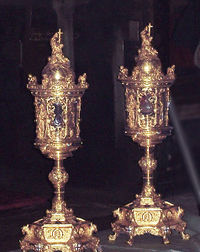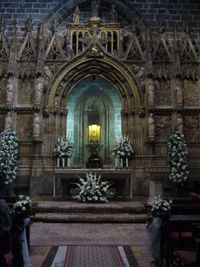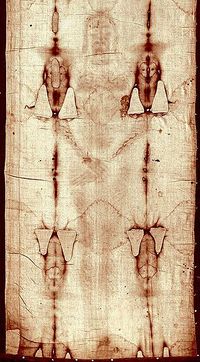Difference between revisions of "Category:Relics of Jesus (subject)"
| Line 1: | Line 1: | ||
[[File:Holy Blood Mantua.jpg|thumb|200px|Relic of the Holy Blood (Mantua, Italy)]] | |||
[[File:Grail Valencia.jpg|thumb|200px|Relic of the Holy Grail (Valencia, Spain)]] | |||
[[File:Shroud Turin.jpg|thumb|200px|The Shroud (Turin, Italy)]] | |||
*[[:Category:Artifacts|BACK to the ARTIFACTS--INDEX]] | *[[:Category:Artifacts|BACK to the ARTIFACTS--INDEX]] | ||
*[[Jesus|BACK to the JESUS--INDEX]] | *[[Jesus|BACK to the JESUS--INDEX]] | ||
Revision as of 04:13, 5 September 2018
Relics of Jesus refers to a series of artifacts (mostly of medieval origin) which were believed to be connected with the historical Jesus.
< Life of Jesus : Nativity of Jesus -- Childhood of Jesus -- Jesus' Hidden Years -- Ministry of Jesus (Parables of Jesus, Miracles of Jesus) -- Passion of Jesus -- Resurrection of Jesus -- Relics of Jesus >
- This page was created and is edited by Gabriele Boccaccini, University of Michigan
Overview
It was common practice in the ancient Church to preserve and venerate relics of Christian saints and martyrs.
Christian teaching states that Jesus was assumed into heaven corporeally. Therefore the only relics that could be collected were either objects belonging to, or touch by, Jesus, or parts of his body he had lost prior to his resurrection-—hair, blood, fingernails, milk teeth, his prepuce (from his circumcision), and the umbilicus (from his birth).
Reliquaries containing bodily parts of Jesus could actually be commonly found in Europe during the Middle Ages. As an example, at that time there were as many as 18 churches claiming possession of the Holy Prepuce of Jesus: in Italy, France, Germany, Belgium, etc.
Most of those relics were lost or destroyed during the Reformation or the French Revolution. The authorities of the Catholic Church also began looking with great skepticism to those relics, as all of them were of very dubious provenance (to say the least). The cult of bodily parts of Jesus was discouraged and gradually felt into oblivion.
According to the Catholic Encyclopedia, "Very little reliance can be placed upon the authenticity of these specimens.” There is neither reliable, conclusive evidence nor historical record supporting the identification of these relics as genuine. On the contrary, all evidence leads to the conclusion that the search and collection of relics of Jesus started not before the fourth century CE and reached its climax during the Middle Age at the time of the Crusades.
While scholars dismiss the authenticity of all these ancient relics, the interest in Jesus' relics has lately increased in fictional and arch-fi circles, which speculate especially on the possibility of extracting Jesus' DNA for cloning; see Jesus Cloning.
List of major Relics associated with Jesus
Nativity of Jesus
Preaching of Jesus
- Mensa Christi ('"Table of Jesus)
Last Supper
Arrest and Trial of Jesus
- Holy Prison (Prison of Jesus)
A column, preserved at the Church of Santa Prassede in Rome, is only one of the many columns that are said to be the Column of the Flagellation.
Crucifixion, Burial, and Resurrection of Jesus
External links
Pages in category "Relics of Jesus (subject)"
This category contains only the following page.
Media in category "Relics of Jesus (subject)"
This category contains only the following file.
- 2007 Nickell.jpg 314 × 499; 24 KB



